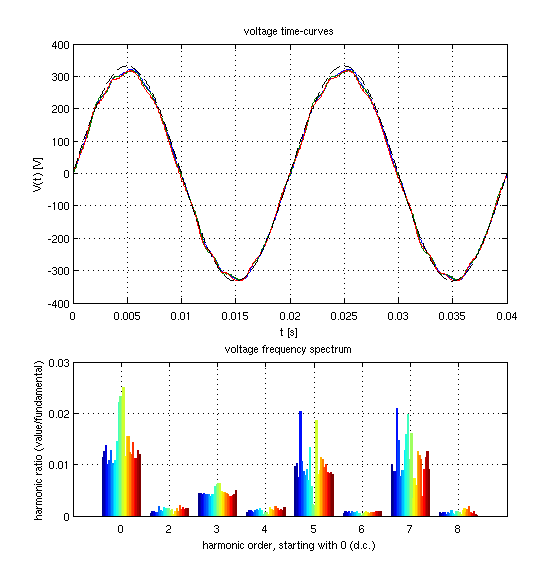
There's quite a lot of discussion of standby power nowadays. It would be interesting to see how much computers really take when on standby, but it's not obvious that cheap power meters will measure this properly when there may be very capacitive currents from filters, or very non-sinusoidal currents. Also, for those of us who hardly know what standby is, our computers being left on day and night, it would be interesting to know the computers' running consumption, and how much this is affected by CPU activity or number and activity of hard-disks. The currents drawn by most computer equipment are highly non-sinusoidal in any mode of operation; what is the form of the current?
These questions are answered for some computers and monitors, in the following results. Measurements have been made with an oscilloscope (Tektronix TDS 3052), of the voltage across and the current into these devices.
For the interested, there is some more detail about the measurement method.
After doing these measurements, one simple plug-in power meter was found to be quite accurate even with harmonics and capacitive loads, so some more appliance_powers were measured for some domestic loads, including just `power' (W) and `apparent power' (VA) rather than the full harmonic details.
There are also some old measurements of harmonic currents (and general power consumption) of `low energy' lamps.
The supply voltage was close to its nominal 230 V rms for all the measurements. The waveform's features, mainly a depression just before the peak, were quite steady over time.
Three example waveforms are shown in top of the following figure, besides a pure sinusoid (dashed line) as a reference. Below that, the spectrum of voltage amplitudes at some low harmonic frequencies is shown, for all of the measurement occasions.
The "dc" level
(0th harmonic) cannot be taken seriously, as the oscilloscope
is known to have some small voltage-offset that was not taken
into account back in the days of these quick measurements.

For each item, the currents are shown plotted against time, with one curve for each operating mode measured.
The matlab script that was used to process the results is here: plot_it_power.m. The results from the oscilloscope are condensed in this: raw_data_vi.m, called by the above script; just current and voltage columns from the original CSV files have been used, verbatim (the times are always taken as being 0--40 ms).
Some single-value indices have been calculated for the v(t) and i(t) curves.
This is a home-made desktop machine, currently in use as a headless backup server, with three disks. It runs RedHat Enterprise 5, 64-bit. The processor is an AMD Athlon64 3700+, which runs at 1000 or 1800 or 2200 MHz depending on loading (`AMD power-now'). The memory is two lots of 400 MHz DDR, and the motherboard is an Asus A8V-E SE with VIA K8T890 chipset.
Five different states were used. In the order in which the results are given, these were:
Name Vrms Vpk Irms Ipk Srms Preal PF
'backup_off' 228.0 328.8 0.054 0.154 12.2 5.6 0.46
'backup_3spundown' 227.8 330.9 0.363 0.888 82.6 63.6 0.77
'backup_normal' 228.3 332.5 0.439 1.007 100.1 79.0 0.79
'backup_fullcpu' 227.8 328.8 0.722 1.620 164.6 126.9 0.77
'backup_fullcpu_muchdisk' 227.2 328.1 0.779 1.742 177.0 136.0 0.77
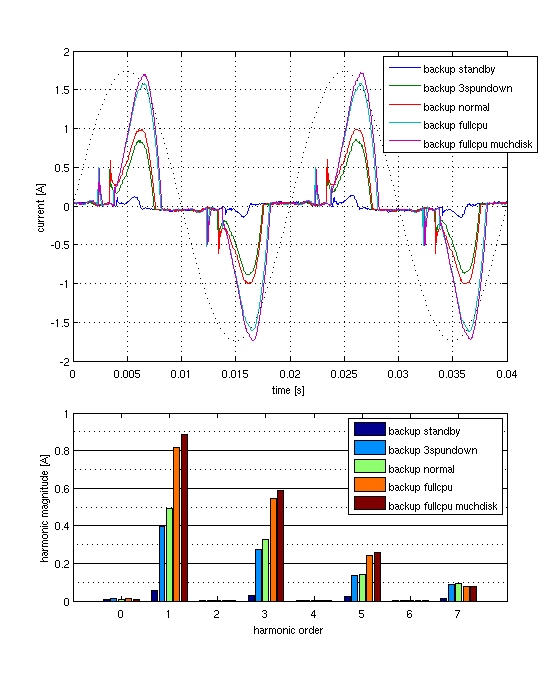
Clearly, the CPU loading has a strong effect, increasing the 80 W idle power
by 45 W. Heavy use of three disks made only a 10 W increase above this
(try again with disk loading without high CPU use?). Turning off three idle disks
made about a 15 W reduction of the 80 W idle power. Even when supposedly turned
off (at the front) this computer takes about 6 W.
This is a Dell Optiplex GX260, with a 2.4 GHz P4 (no HT); it contains either 4 disks (all about 40 GB, four to six or so years old) or just 1 disk by disconnecting the other three from the power and signal connectors before booting. The operating system is Solaris 10 x86 (05/08), running with GUI.
Five different states were used. In the order in which the results are given, these were:
Name Vrms Vpk Irms Ipk Srms Preal PF
'solar_off' 228.7 332.4 0.121 0.213 27.7 2.1 0.07
'solar_onguiidle1disk' 228.2 330.3 0.281 0.788 64.2 41.7 0.65
'solar_onguiidle4disk' 228.6 330.6 0.358 0.972 81.8 55.9 0.68
'solar_onguiidle1diskthrash' 228.3 331.6 0.304 0.854 69.5 46.8 0.67
'solar_onguifullcpu4disk' 226.9 328.4 0.587 1.452 133.3 98.7 0.74
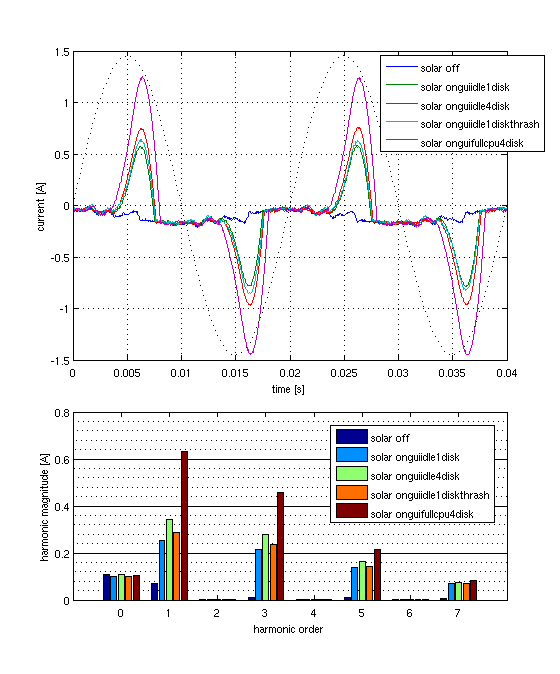
This suggests that idle hard-disks don't take much power; it is about
14 W change for three hard-disks being present rather than not.
The difference between idle and hard-working disks is again small,
about 5 W each. The difference between CPU load being zero and full
is much bigger, a bit over 40 W, very similar to the AMD64 case although
the P4 doesn't have an explicitly mentioned speed reduction for
power saving (?). Note that the off-state current (and the others states'
currents, less noticeably) has a component suggestive of a [noisy]
capacitor current, in contrast to the current in the other computer `backup'.
This is a normal, old desktop computer, adapted to hold three disks connected to a hardware raid controller in raid5, as a fileserver. The OS is FreeNAS (a FreeBSD derivative), running on a flash disk. In this case we also have the opinions of two different makes of power-meter, to compare with the oscilloscope's results. The measurements by the three different instruments were not made at the same time, since the instruments consumed considerable reactive power themselves, so any `daisy-chaining' of the measurements would have loaded up-stream instruments with the down-stream ones.
Four different states were used. In the order in which the results are given, these were:
At the end of the following table, the results of power (`W', suggesting active power) of both of the plug-in power meters are given.
Name Vrms Vpk Irms Ipk Srms Preal PF M1 M2 'p3fn_off' 226.6 332.1 0.245 0.427 55.4 -0.8 -0.01 22 1 'p3fn_idle' 226.2 331.4 0.412 0.997 93.2 62.2 0.67 69 61 'p3fn_fullcpu' 226.7 332.0 0.460 1.118 104.3 75.0 0.72 84 76 'p3fn_full3raid' 229.6 336.9 0.504 1.274 115.8 83.0 0.72 88 83
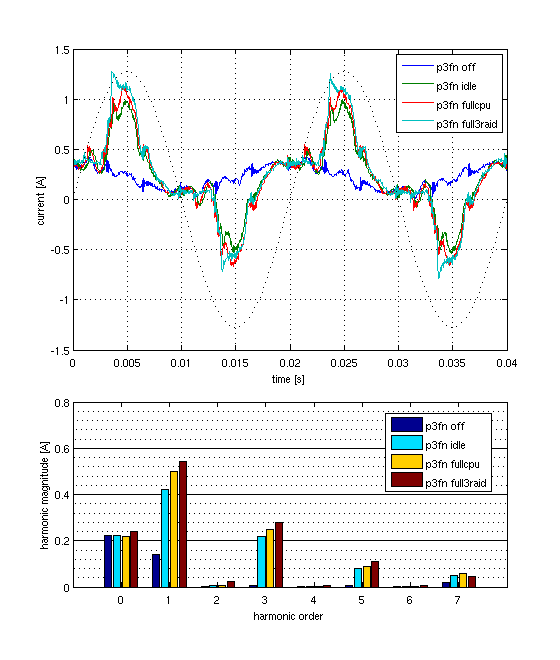
It is noteworthy that the difference between idle and fullcpu is pretty small,
less than 25% increase. The hard use of disks gives a bigger increase,
but this activity causes about 80% CPU use anyway, so part of the increase
is CPU even in the full3raid case. This isn't a very good example of a PIII
computer, on account of the unusually new and high-quality power supply.
This is a rack-mounted fileserver, 2006 vintage, with dual Opteron 248 2.2 GHz CPUs, 2 GB of memory, and eight SCSI U320 10krpm disks. One disk is for the system, six are in RAID5 (linux 'md raid') and the eighth is a hot spare. The OS is RedHat Enterprise 5, 64 bit. There are three power supplies in the computer's back, each able to run it at full power; this feature was used to make the measurements without turning the server off.
Five different states were used. In the order in which the results are given, these were:
Name Vrms Vpk Irms Ipk Srms Preal PF
'penguin_idle3pow' 225.7 326.1 0.420 0.895 94.8 82.1 0.87
'penguin_idle1pow' 225.2 326.3 1.035 1.970 233.2 219.5 0.94
'penguin_diskload' 225.8 328.6 1.405 2.589 317.2 301.7 0.95
'penguin_fullcpu' 226.0 326.2 1.440 2.544 325.4 310.2 0.95
'penguin_fullcpudiskload' 225.2 325.1 1.522 2.640 342.8 327.7 0.96
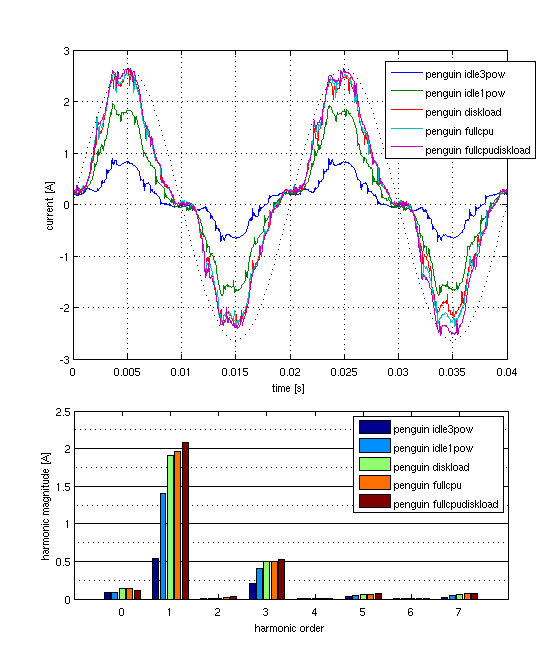
This is the only bit of equipment seen here that has its current quite well centred on the voltage peak and spread over much of the cycle. The power factors are quite high, and harmonics beyond the third are very small.
Full CPU loading adds only about 40% to the consumption.
Disk usage makes little difference: about 20 W for all.
Spinning down disks was not tried, as there is almost
always some use of the disks. Since the CPU usage
due to the heavy file writing is about 1½--2 fully loaded
CPUs (mainly in `system' state rather than user), the
comparison of fullcpu and fullcpudiskload is the best
estimate of disk consumption. It was not noted whether
the apparently highly loaded CPUs during copying were
running at low or full speed. During heavy disk use, the
current trace on the oscilloscope moved up and down by a
factor of some 25% or so; a middlish value was taken
for the capture and data transfer.
This is a large, Trinitron-based Cathode Ray Tube (CRT) monitor, Dell model P992. Rated `power' is 2 to 1 A, at 100 to 240 V; there's no mention of peak, rms, etc.
The power consumption, when off at the button on the front, is very small, yet the apparent power is much more; a filter or power-factor capacitor is probably responsible for the quite sinusoidal phase-leading off-state current. The `onblank' state is when the monitor is turned on but with only a dark screen to its signal input. `ongui' is running with a colourful login screen being displayed. The power consumption is quite high -- nearly 100 W.
Name Vrms Vpk Irms Ipk Srms Preal PF
'big_crtmon_off' 228.7 332.5 0.072 0.143 16.4 0.6 0.04
'big_crtmon_onblank' 229.3 331.7 0.412 1.041 94.5 68.2 0.72
'big_crtmon_ongui' 227.8 328.6 0.541 1.312 123.3 91.8 0.74
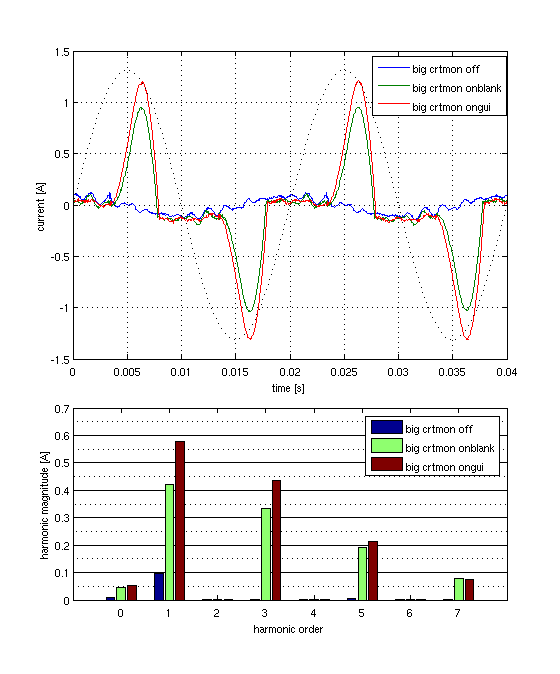
This is a flat-panel TFT monitor, Dell model 1707FPf, rated at 2 A, 100 to 240 V. The current suggests a shunt capacitor somewhere on the input, and the input converter clearly takes a pulse centred on the voltage peak, much smaller on standby than on normal operation. Power consumption is only 30 W or so.
Name Vrms Vpk Irms Ipk Srms Preal PF
'tftmon_off' 227.3 331.2 0.032 0.081 7.2 0.6 0.08
'tftmon_ongui' 228.5 331.1 0.268 1.031 61.3 28.7 0.47
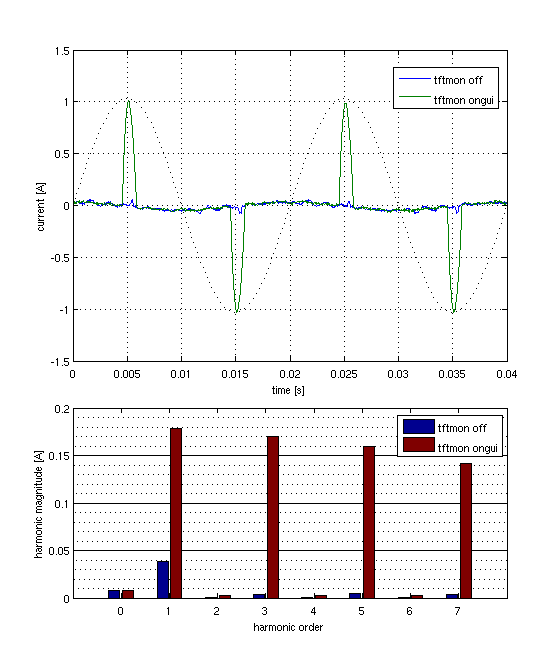
Page started: 2008-08-02
Last change: 2009-02-13